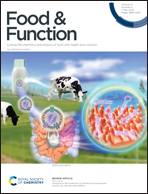Isolation and identification of an α-glucosidase inhibitory peptide from extruded soybean protein and its hypoglycemic activity in T2DM mice†
Abstract
Although extruded soybean protein (ESPro) is currently used during the production of plant-based meats, studies involving its hypoglycemic activity in vitro and in vivo are minimal. In this study, the α-glucosidase inhibitory activity of ESPro with different extrusion parameters was compared and ESPro1 (160 °C, 30 rpm) was found to have the highest inhibitory activity. Then, simulated digestion and ultrafiltration of ESPro1 were carried out in vitro and an ESPro1 digestion product (<1 kDa) with the highest inhibitory activity was obtained. Gel filtration chromatography separation was further performed to obtain an ESPro1 F3 fraction with the highest inhibitory activity. Finally, six peptides with α-glucosidase inhibitory activity were screened from the ESPro1 F3 fraction and synthesized using solid-phase synthesis, among which LLRPPK showed the highest inhibitory activity (46.98 ± 0.63%). During a four-week dietary intervention in type 2 diabetes mellitus (T2DM) mice, ESPro attenuated the trend of weight loss, reduced blood glucose, alleviated insulin resistance, and improved glucose tolerance, while ESPro1 reduced blood glucose levels by 22.33% at 28 d. Furthermore, ESPro1 significantly increased the serum high-density lipoprotein cholesterol (HDL-C) levels, decreased the low-density lipoprotein cholesterol (LDL-C) levels, up-regulated the superoxide dismutase (SOD) and glutathione peroxidase (GSH-Px) activity, reduced the malondialdehyde (MDA) content, down-regulated the alanine aminotransferase (ALT) and aspartate aminotransferase (AST) activity, and alleviated liver and pancreatic injury in T2DM mice. Overall, ESPro1 (160 °C, 30 rpm) displayed a superior hypoglycemic effect in vivo and in vitro and may have a beneficial impact on T2DM treatment.



 Please wait while we load your content...
Please wait while we load your content...